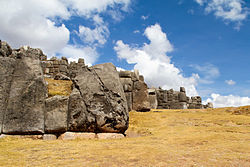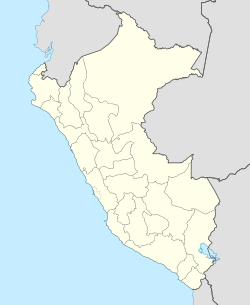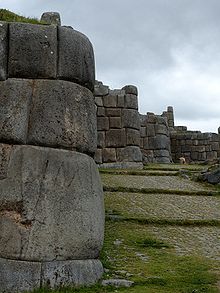- Sacsayhuamán
-
Sacsayhuamán 
Location Coordinates 13°30′28″S 71°58′56″W / 13.50778°S 71.98222°WCoordinates: 13°30′28″S 71°58′56″W / 13.50778°S 71.98222°W Culture Inca empire Country Peru Region Cusco Controlling city Cusco Elevation 3,701 m (12,142 ft) Sacsayhuamán (also known as Saksaq Waman, Sacsahuaman or Saxahuaman) is a walled complex on the northern outskirts of the city of Cusco, Peru, the former capital of the Inca empire. The complex is as many other Inca constructions made of large polished dry-stone walls, each boulder carefully cut to fit together tightly without mortar.
The site, at an altitude of 3,701 m, was added as part of the city of Cusco to the UNESCO World Heritage List in 1983.
Contents
Description
Located on a steep hill that overlooks the city, it contains an impressive view of the valley to the southeast. Surface collections of pottery at Sacsayhuaman indicate that the earliest occupation of the hill top dates back at least a millennium.[citation needed]
Because of its location high above Cuzco and its immense terrace walls, this area of Sacsayhuaman is frequently referred to as a fortress.[1] Some writers also believe the complex was built specifically to represent the head of a puma, the effigy shape which Sacsayhuamán together with Cuzco forms when seen from above.[citation needed] The importance of its military functions was highlighted in 1556 when Manco Inca lay siege to Cuzco.[2] Much of the fighting occurred in and round Sacsayhuaman as it was critical for maintaining control over the city. It is clear from descriptions of the siege, as well as from excavations at the site, that there were towers on its summit as well as a series of other buildings.[citation needed] For example Pedro Sancho, who visited the complex before the siege, mentions the labyrinth like quality of the complex and the fact that it held a great number of storage rooms filled with a wide variety of items.[citation needed] He also notes that there were buildings with large windows that looked over the city. These structures, like so much of the site, have long since been destroyed.[3]
Other early accounts of Cuzco indicate that Sacsayhuaman included a Sun Temple,[citation needed] which suggests that the complex was the focus of ritual activities as well. The large plaza area, capable of holding thousands of people, is well designed for ceremonial activities and several of the large structures at the site may also have been used during rituals.[citation needed] It is also clear from early accounts that the complex held a great number of storage rooms.[citation needed] Pedro Pizarro, describes the storage rooms that were within the complex and which were filled with military equipment.[4]
The best-known zone of Sacsayhuaman includes its great plaza and its adjacent three massive terrace walls. The stones used in the construction of these terraces are among the largest used in any building in prehispanic America and display a precision of fitting that is unmatched in the Americas.[5] The stones are so closely spaced that a single piece of paper will not fit between many of the stones. This precision, combined with the rounded corners of the blocks, the variety of their interlocking shapes, and the way the walls lean inward, is thought to have helped the ruins survive devastating earthquakes in Cuzco. The longest of three walls is about 400 meters. They are about 6 meters tall. The estimated volume of stone is over 6,000 cubic meters. Estimates for the weight of the largest limestone block vary from 128 tonnes to almost 200 tonnes.[6][7]
Following the siege of Cuzco, the Spaniards began to use Sacsayhuaman as a source of stones for building Spanish Cuzco and within a few years much of the complex was demolished. The site was destroyed block-by-block to build the new governmental and religious buildings of the city, as well as the houses of the wealthiest Spaniards. In the words of Garcilaso de la Vega (1966:471 [1609: Part 1, Book. Bk. 7, Ch. 29]): “to save themselves the expense, effort and delay with which the Indians worked the stone, they pulled down all the smooth masonry in the walls. There is indeed not a house in the city that has not been made of this stone, or at least the houses built by the Spaniards.” Today, tragically, only the stones that were too large to be easily moved remain at the site.[8]
On 13 March 2008, archaeologists discovered additional ruins at the periphery of Sacsayhuaman. They are believed to have been built by the Killke culture, while clearly ceremonial in nature, the exact function remains unknown. These people built structures and occupied the site for hundreds of years before the Inca, between 900 and 1200 AD.[9]
In January 2010, parts of the site were damaged during periods of heavy rainfall in the region.[10]
Theories about construction of walls
The Inca used similar construction techniques in building Sacsayhuaman as they used on all their stonework, albeit on a far more massive scale.[11] The stones were rough-cut to the approximate shape in the quarries using river cobbles.[12] They were then dragged by rope to the construction site, a feat that at times required hundreds of men.[13] The ropes were so impressive that they warranted mention by Diego de Trujillo (1948:63 [1571]) as he inspected a room filled with building materials. The stones were then shaped into their final form at the building site and then laid in place.[14] The work, while supervised by Inca architects, was largely carried out by groups of individuals fulfilling their labor obligations to the state. In this system of “mita” or “turn” labor, each village or ethnic group provided a certain number of individuals to participate in public works projects.[15]
Although multiple regions might provide labor for a single, large-scale state project, the ethnic composition of the work-gangs remained intact, as different groups were assigned different tasks. Cieza de León (1976:153-154), who visited Sacsayhuaman two times in the late 1540’s, mentions the quarrying of the stones, their transposition to the site, and the digging of foundation trenches. All this was conducted by rotational labor under the close supervision of Imperial architects.[16]
Vince Lee is an author, architect, and explorer who has studied and consulted on various ancient sites where people moved large megaliths. He theorized that the blocks at Sacsayhuaman were put into place by carving them and then lowering them into place. The stones would have been precisely carved in advance to create the tight joints made to fit into prepared pockets in the wall. Then the stones would be towed up a ramp and above the wall, where they would be placed on top of a stack of logs. The logs would be removed one at a time to lower the stones into place. In contrast Protzen, a professor of architecture, has shown how the Inca built long and complex ramps within the stone quarries near Ollantaytambo, and how additional ramps were built to drag the blocks to the construction above the village.[17] He suggests that similar ramps would have been built at Sacsayhuaman.
Modern-day use
Today, Peruvians celebrate Inti Raymi, the annual Inca festival of the winter solstice and new year. It is held near Sacsayhuamán on 24 June. Some Cusqueños use the large field within the walls of the complex for jogging, t'ai chi, and other athletic activities.
References
- ^ Bauer 2007
- ^ Hemming 1970; Conquest of the Incas
- ^ Hyslop 1990, Bauer 2007
- ^ Pizarro 1921:272-273
- ^ Bauer (2007) Ancient Cuzco. University of Texas Press
- ^ Seventy Wonders of the Ancient World, ed. Chris Scarre, 1999 pp. 220-3
- ^ Readers Digest: "Mysteries of the Ancient Americas: The New World Before Columbus", 1986, p. 220-1
- ^ Bauer (2007) Ancient Cuzco. University of Texa Press
- ^ "Pre-Inca temple uncovered in Peru", CNN, 15 Mar 2008, retrieved on 16 March 2008.
- ^ Heavy rainfall in Peru BBC News, 26 January 2010
- ^ Bauer 2007
- ^ (Protzen 1986; 1991)
- ^ (Gutierrez de Santa Clara 1963:252 [ca. 1600])
- ^ (Lee 1986)
- ^ Bauer 2007
- ^ Bauer 2007
- ^ Protzen, Jean-Pierre; Batson, Robert (1991). Inca architecture and construction at Ollantaytambo. Oxford University Press. pp. 165, 175. ISBN 978-0-19-507069-9.
See also
- List of megalithic sites
External links
- BBC Article New Discoveries at Sacsayhuamán
Archaeological sites in Peru  Acaray | Aspero | Bandurria | Buena Vista | Cahuachi | Cajamarquilla | Carajía | Caral | Cerro Pátapo | Chan Chan | Chankillo | Chavín de Huantar | Choquequirao | Coricancha | Cota Coca | Cumbe Mayo | Cusichaca valley | El Brujo | Garagay | Gran Pajáten | Gran Vilaya | Guitarrero Cave | Huaca de la Luna | Huaca del Sol | Huaca Pucllana | Huayna Picchu | Huilcahuain | Incahuasi, Ayacucho | Incahuasi, Cañete | Intihuatana | Jiskairumoko | Kenko | Kuelap | Kuntur Wasi | Llactapata | Machu Picchu | Miculla petroglyphs | Muyucmarca | Ollantaytambo | Pachacamac | Pikillacta | Pikimachay | Piruro | Písac | Puca Pucara | Pumacocha | Puyupatamarca | Qoriwayrachina | Raqchi | Rumicolca | Sacred Valley | Sacsayhuamán | Sayhuite | Sechin, Peru | Sillustani | Sipán | Tambo Colorado | Tambomachay | Tarahuasi | Tipón | Toquepala Caves | Toro Muerto | Túcume | Uchkus–Inkañan | Vilcabamba | Vitcos | Wari ruins | Wiñay Wayna | YanacaCategories:
Acaray | Aspero | Bandurria | Buena Vista | Cahuachi | Cajamarquilla | Carajía | Caral | Cerro Pátapo | Chan Chan | Chankillo | Chavín de Huantar | Choquequirao | Coricancha | Cota Coca | Cumbe Mayo | Cusichaca valley | El Brujo | Garagay | Gran Pajáten | Gran Vilaya | Guitarrero Cave | Huaca de la Luna | Huaca del Sol | Huaca Pucllana | Huayna Picchu | Huilcahuain | Incahuasi, Ayacucho | Incahuasi, Cañete | Intihuatana | Jiskairumoko | Kenko | Kuelap | Kuntur Wasi | Llactapata | Machu Picchu | Miculla petroglyphs | Muyucmarca | Ollantaytambo | Pachacamac | Pikillacta | Pikimachay | Piruro | Písac | Puca Pucara | Pumacocha | Puyupatamarca | Qoriwayrachina | Raqchi | Rumicolca | Sacred Valley | Sacsayhuamán | Sayhuite | Sechin, Peru | Sillustani | Sipán | Tambo Colorado | Tambomachay | Tarahuasi | Tipón | Toquepala Caves | Toro Muerto | Túcume | Uchkus–Inkañan | Vilcabamba | Vitcos | Wari ruins | Wiñay Wayna | YanacaCategories:- Archaeological sites in Peru
- Ruins in Peru
- Inca
- Esoteric anthropogenesis
- Killke culture
Wikimedia Foundation. 2010.



